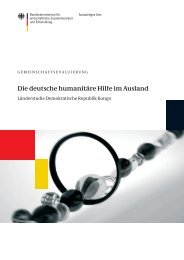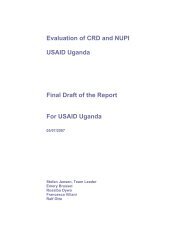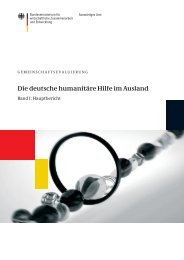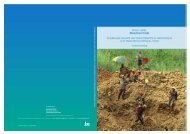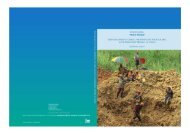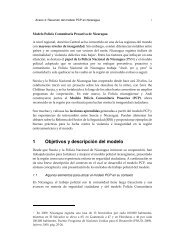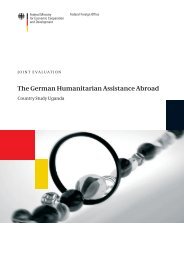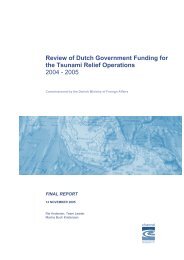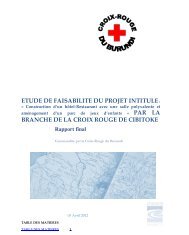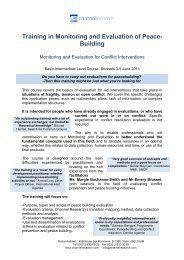A ripple in development? - Channel Research
A ripple in development? - Channel Research
A ripple in development? - Channel Research
You also want an ePaper? Increase the reach of your titles
YUMPU automatically turns print PDFs into web optimized ePapers that Google loves.
In 2005 prior to the peace agreement <strong>in</strong> August 2006, (the former)<br />
GAM stronghold districts <strong>in</strong> the east coast received little aid amount<strong>in</strong>g<br />
to less than 10% of total aid. But this has improved over time where<br />
both tsunami affected and conflict affected populations are receiv<strong>in</strong>g<br />
aid. Still when look<strong>in</strong>g at the f<strong>in</strong>d<strong>in</strong>gs from our quantitative survey, it<br />
can be noted that there is a consistent perception (both <strong>in</strong> 2005 and <strong>in</strong><br />
2008) that conflict affected populations are receiv<strong>in</strong>g less aid than tsunami<br />
affected populations. As <strong>in</strong>dicated <strong>in</strong> the Tsunami Recovery Indicators<br />
for Aceh and Nias <strong>in</strong> table 6, 12 districts lag beh<strong>in</strong>d, many of<br />
which were not directly affected by the tsunami.<br />
Based on full freedom of movement after the sign<strong>in</strong>g of the peace<br />
agreement, it could be expected that the population would move from<br />
one district to another <strong>in</strong> search of better livelihood opportunities. However<br />
our survey statistics show that communities tend not to move from<br />
their orig<strong>in</strong>al sub-districts. Contrary to expectation, <strong>in</strong>dividuals from<br />
poor households were not mov<strong>in</strong>g from their areas which had few <strong>in</strong>come<br />
generat<strong>in</strong>g opportunities to areas where there were better opportunities.<br />
Non-<strong>in</strong>dividual movement from one sub-district to another, or one<br />
district to another, may be expla<strong>in</strong>ed by the low level of skills that <strong>in</strong>dividuals<br />
have. In labour market studies carried out by the Central Bank<br />
of Indonesia and the MDF, it was found that unskilled or low skilled<br />
labour did not have any <strong>in</strong>centive to move from their places of orig<strong>in</strong> as<br />
there were few jobs for unskilled workers <strong>in</strong> the areas with higher economic<br />
<strong>development</strong>. Given the labour market behaviour, it is argued<br />
that the targeted distribution of aid becomes more crucial for households<br />
<strong>in</strong> order to promote livelihoods of any description.<br />
While foreign aid was <strong>in</strong>itially mandated for tsunami recovery and<br />
reconstruction, policy arguments concern<strong>in</strong>g aid for the long term poor<br />
should eventually have resulted <strong>in</strong> <strong>in</strong>creased aid for Nias. While Nias did<br />
not suffer from long term conflict, it is clearly underdeveloped compared<br />
to Aceh with a primarily subsistence based economy. There is<br />
very little trade between Nias and other parts of Sumatera Utara prov<strong>in</strong>ce<br />
and its contribution to the prov<strong>in</strong>cial economy is very small 42 .<br />
Possible reasons as cited by BRR (2007) for this poor prioritisation<br />
<strong>in</strong> aid flows <strong>in</strong>clude the absence of a master plan, limited access to devastated<br />
subdistricts, limited transportation networks and slow disbursement<br />
of foreign aid (public and private). However, the National Development<br />
Plann<strong>in</strong>g Board of Indonesia has classified Nias as be<strong>in</strong>g one of<br />
the underdeveloped Outer Islands <strong>in</strong> the archipelago and as such, a<br />
separate <strong>development</strong> policy applies to Nias. Given such a policy pronouncement,<br />
and the previous statistics on target<strong>in</strong>g of aid, foreign aid<br />
donors have failed to demonstrate that they can override policy <strong>in</strong> favour<br />
of seriously address<strong>in</strong>g poverty alleviation.<br />
42<br />
Asian Development Bank, 2006 and BPS Kabupaten Nias, 2005<br />
61



